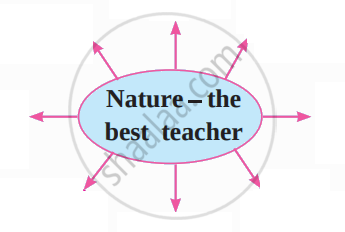Advertisements
Advertisements
प्रश्न
Look at the following things. Discuss with your friend, what you learn from them.
Rainfall
उत्तर
Rainfall teaches us to spread happiness and prosperity everywhere.
APPEARS IN
संबंधित प्रश्न
Rearrange the good qualities in each set, so that the first letter of each of the words should make a meaningful word. Join the sets and get a message.
Set 1: Understanding/Adaptable/Tolerant/Neat/ Encouraging Resourceful.
- The word is _____________
Set 2: Selfless/Inspiring
- The word is ____________
Set 3: Youthful/Modest
- The word is ___________
Set 4: Affectionate/Compassionate/Empathetic/ Earnest/Honest/Reliable/Trustworthy
- The word is _____________
- The message is _______________
What things in nature teach us the following:
Problems are not permanent ___________.
What things in nature teach us the following:
Be humble and adjust ______.
What things in nature teach us the following:
Make the best use of time and opportunity__________.
What things in nature teach us the following:
Many hands make work light ____________.
What things in nature teach us the following:
Delicate structures are not a sign of weakness ______.
Read the question from the lesson. What do they imply?
Are you listening?
Go through the lesson again and complete the flow-chart that highlights the life of a ‘hibiscus’ flower.

The writer explains the contrasting features of ‘water’ and ‘rock’ in the lesson. Write all the features of both water and rock in the given table.
| Water | Rock |
| 1. | 1. |
| 2. | 2. |
| 3. | 3. |
| 4. | 4. |
The writer bas very positively described the different things in nature. Discuss with your partner the special features of coach one of them. Add on the list.
| Part of Nature | Special feature | Value learnt |
| 1. Rainbow | ||
| 2. Caterpillar | ||
| 3. | ||
| 4. | ||
| 5. | ||
| 6. | ||
| 7. |
Think and answer in your own words.
How should you deal with difficulties and problems?
Think and answer in your own words.
‘An oyster turns a grain of sand into a pearl.’ What can we learn from this example?
Think and answer in your own words.
How does nature succeed in its ‘Alchemy’? What can it turn a small person into?
Think and answer in your own words.
Which two aspects of nature teach us to accept change and adjust according to the situation?
Think and answer in your own words.
Why does the writer begin by quoting the lines from William Blake's poem 'Auguries of Innocence'?
Prepare a Fact file of any of the following plants/trees, using the points given.
[coconut / neem / basil / cactus / apple]
- Name of Plant/Tree _________
- Scientific name ___________
- Region and climate ___________
- Features ___________
- Growth _____________
- Size, shape and colour ____________
- Uses __________
- Any special feature ________
'Impossible' itself says 'I M possible'. Do you agree? Justify your answer by citing something that you have experienced or heard from someone.
Look at the following thing. Discuss with your friend, what you learn from them.
A bee
Look at the following thing. Discuss with your friend, what you learn from them.
An eagle
Look at the following thing. Discuss with your friend, what you learn from them.
A creeper
Look at the following things. Discuss with your friend, what you learn from them.
The river
Look at the following things. Discuss with your friend, what you learn from them.
Sun
The writer explains the contrasting features of ‘water’ and ‘rock’ in the text. Write all the features of both water and rock in the given table.
| Water | Rock |
| 1. | 1. |
| 2. | 2. |
| 3. | 3. |
| 4. | 4. |
Impossible itself says ‘I M possible’. Do you agree? Justify your answer by citing some examples from the text and some that you have experienced or heard from someone.
Go through the text again and complete the web that highlights the various features of flower of the ‘hibiscus’ plant. One is done for you.

Role of Nature: Discuss in pairs, the role played by nature and complete the web diagram.


